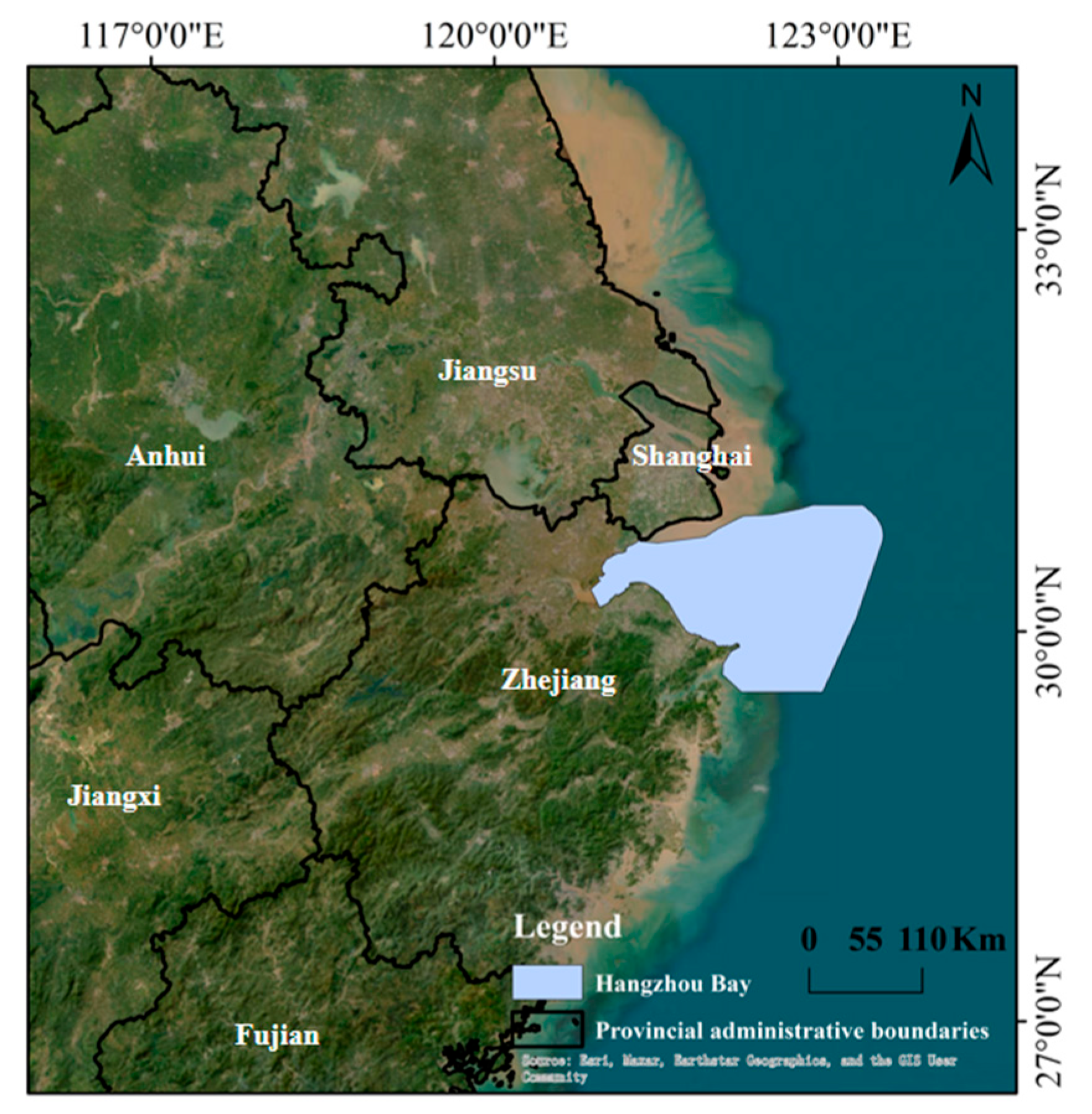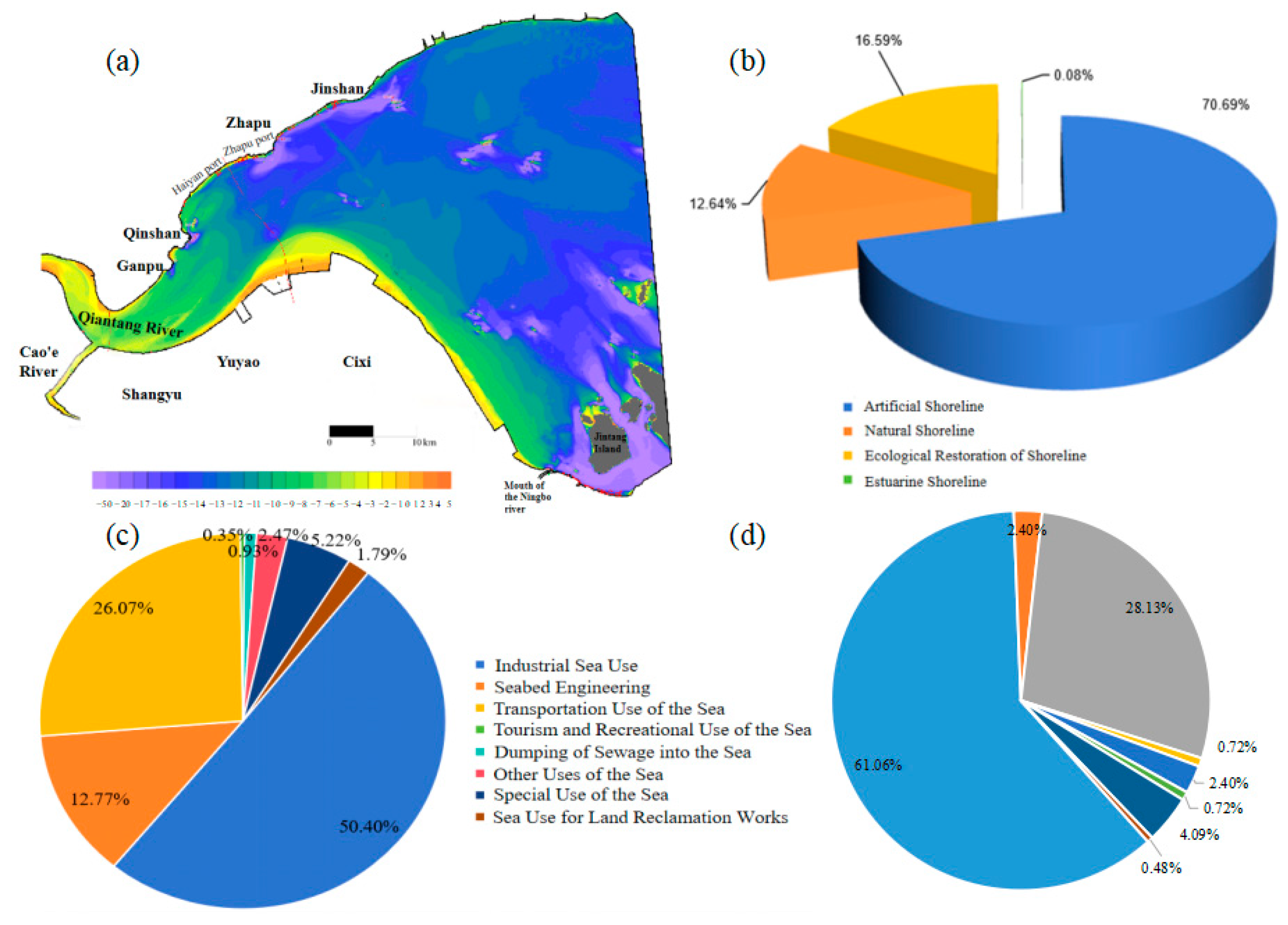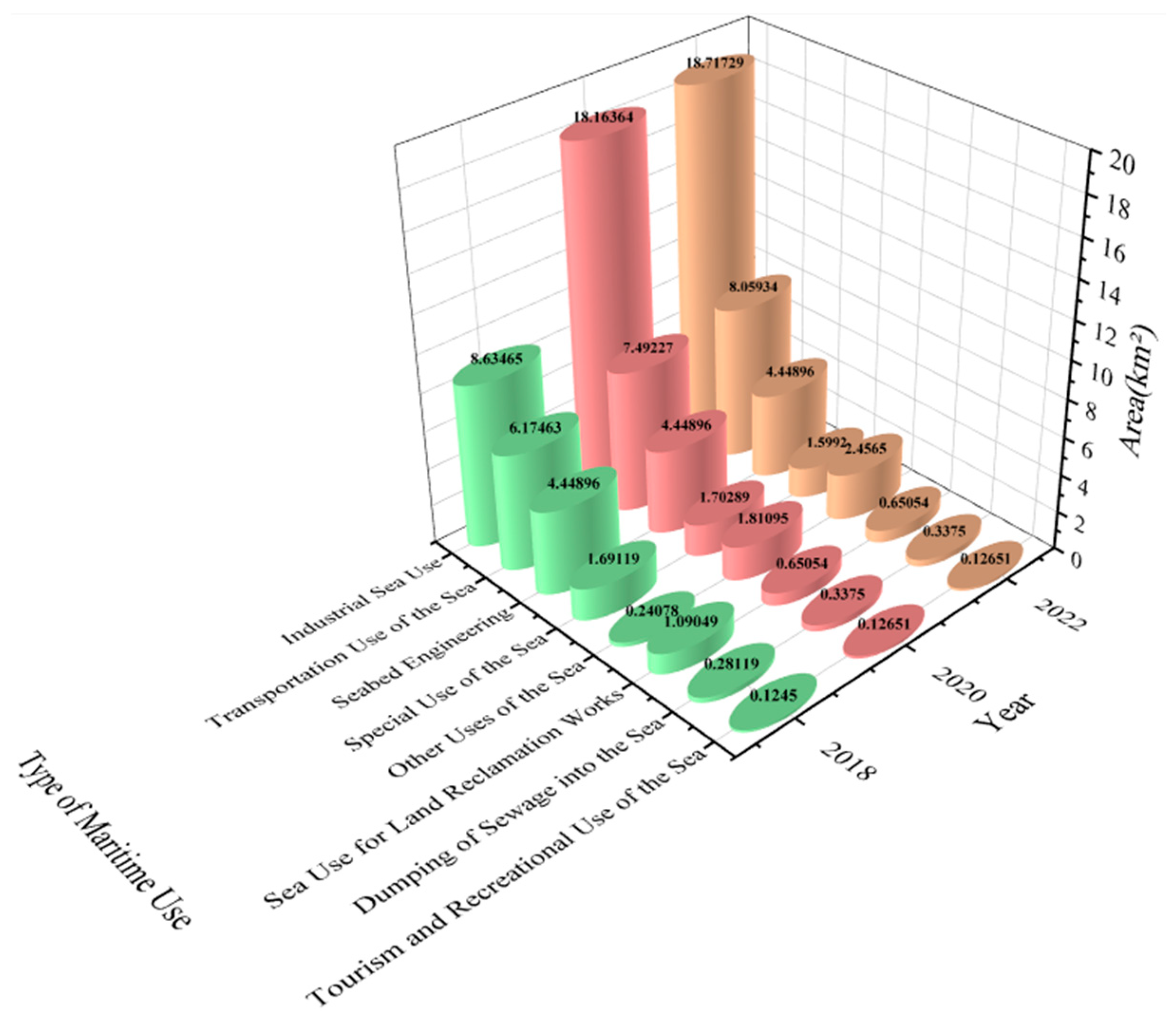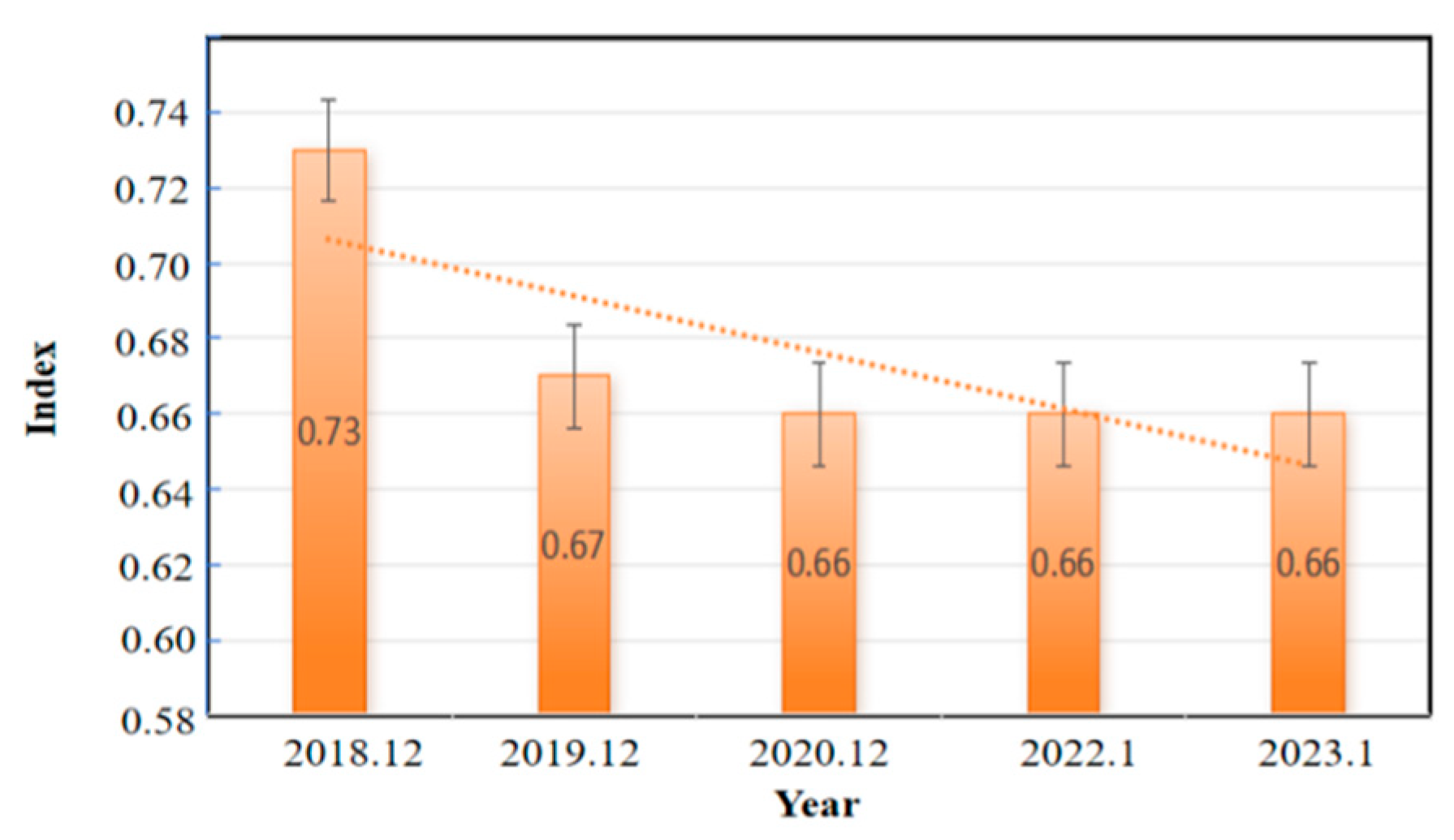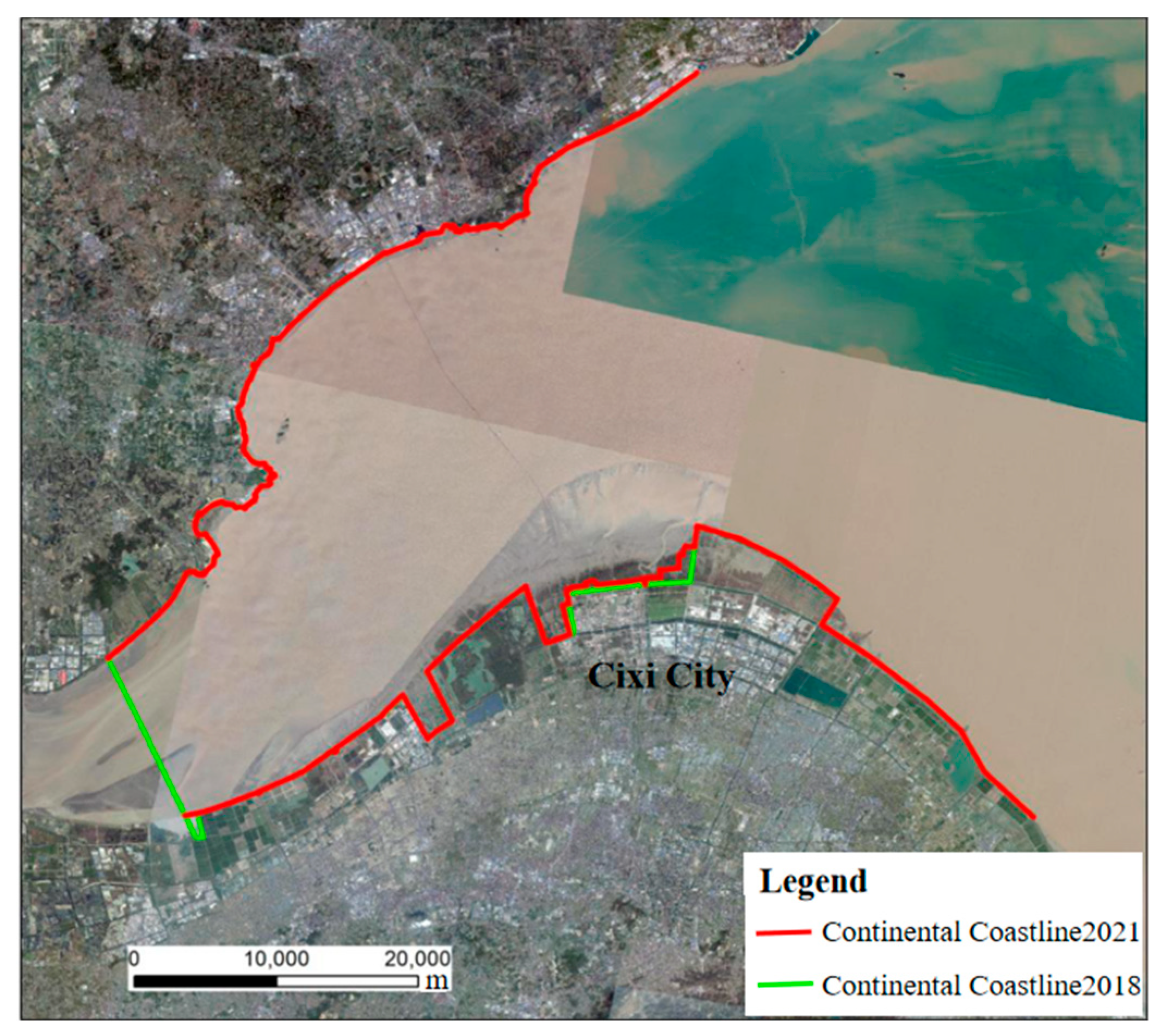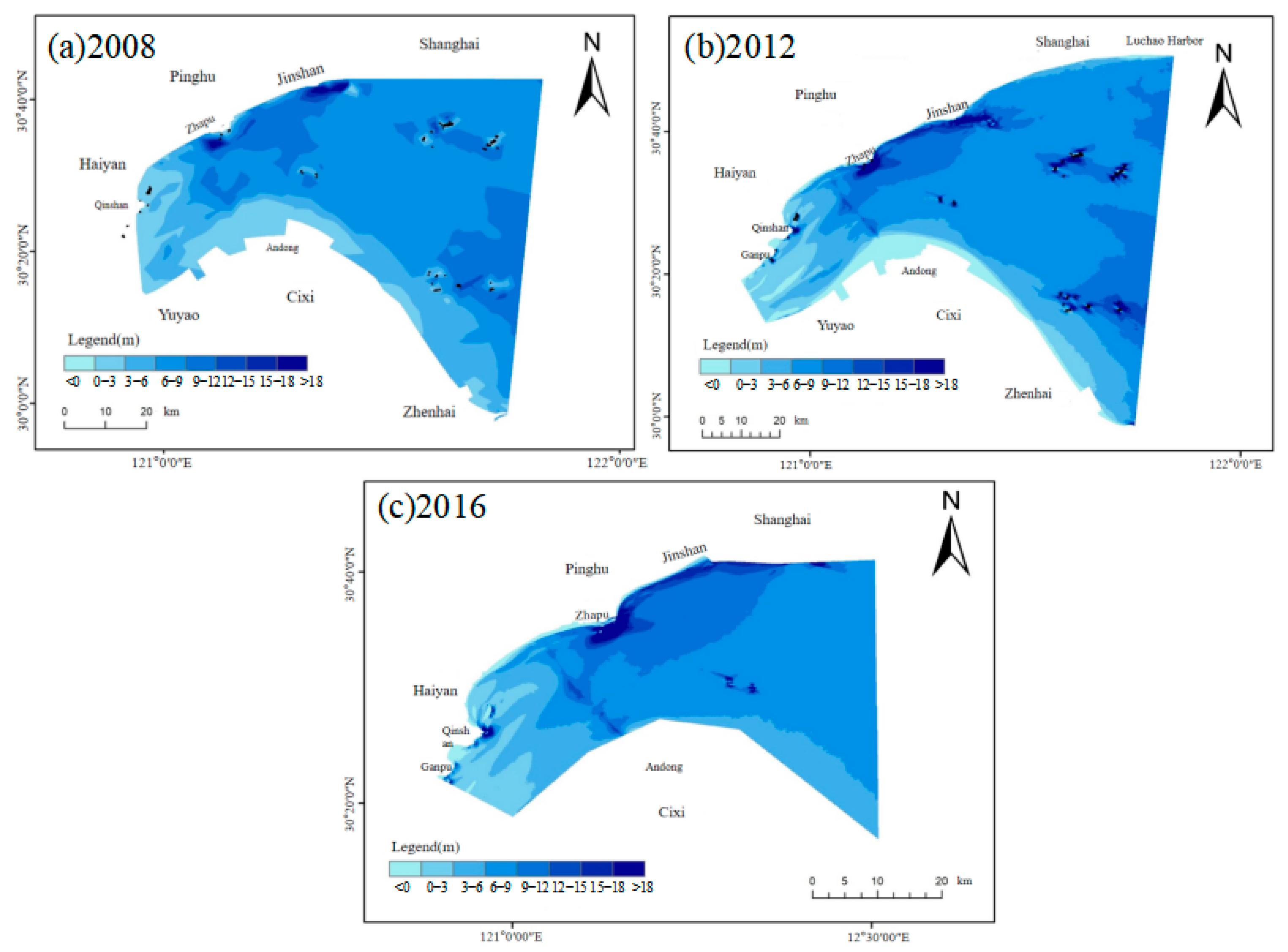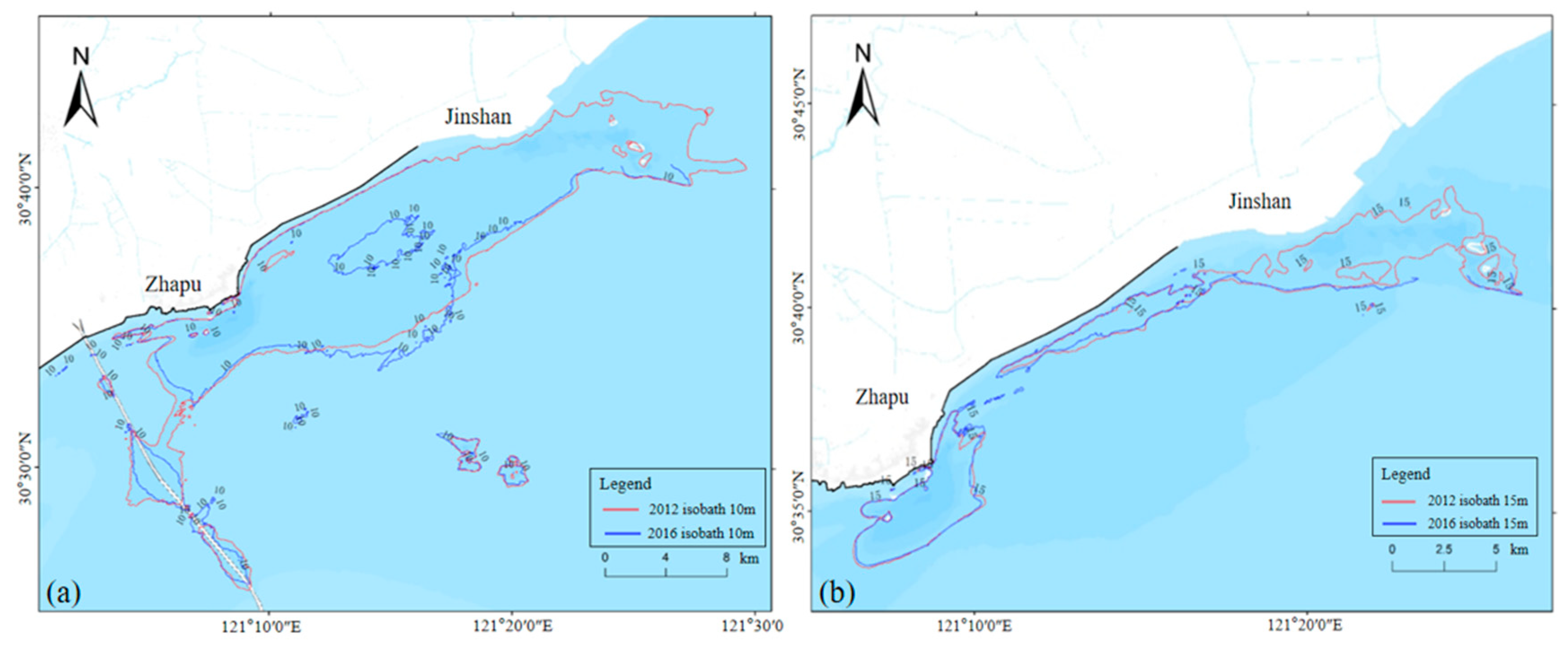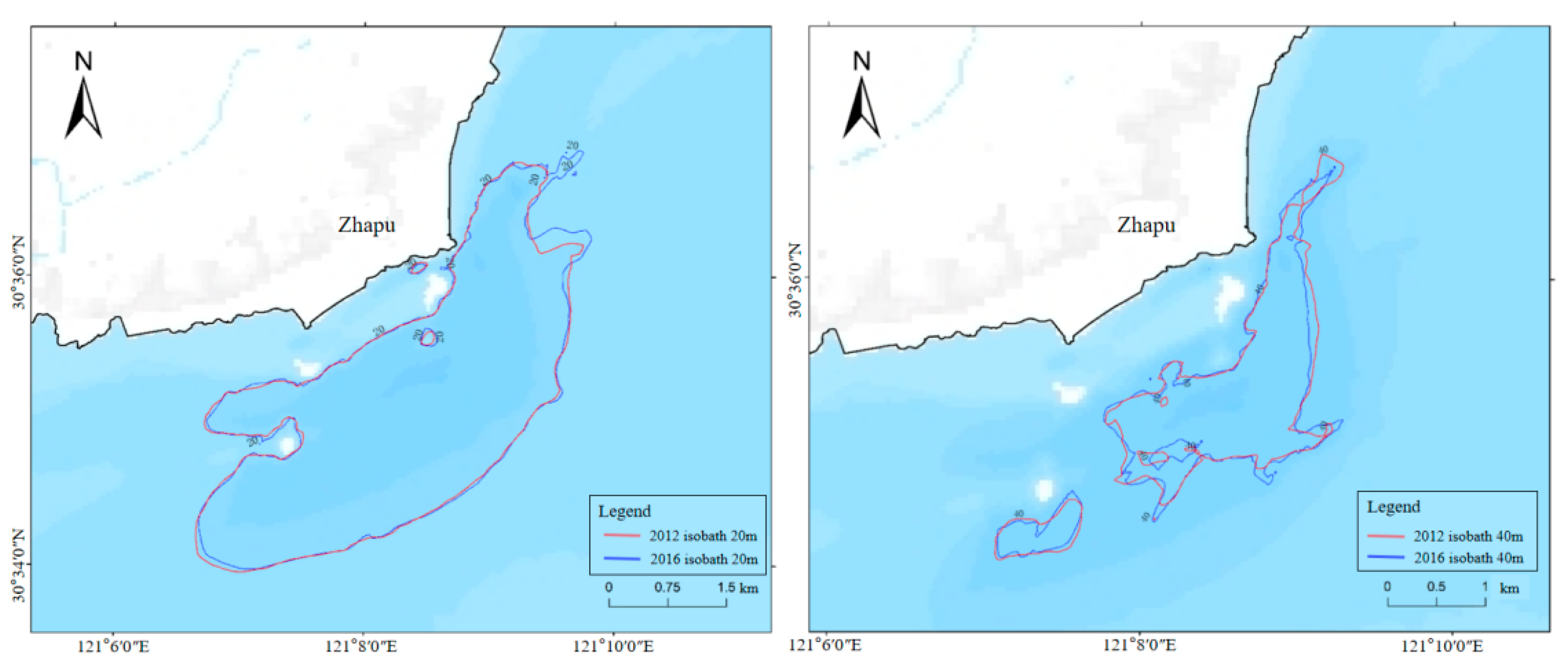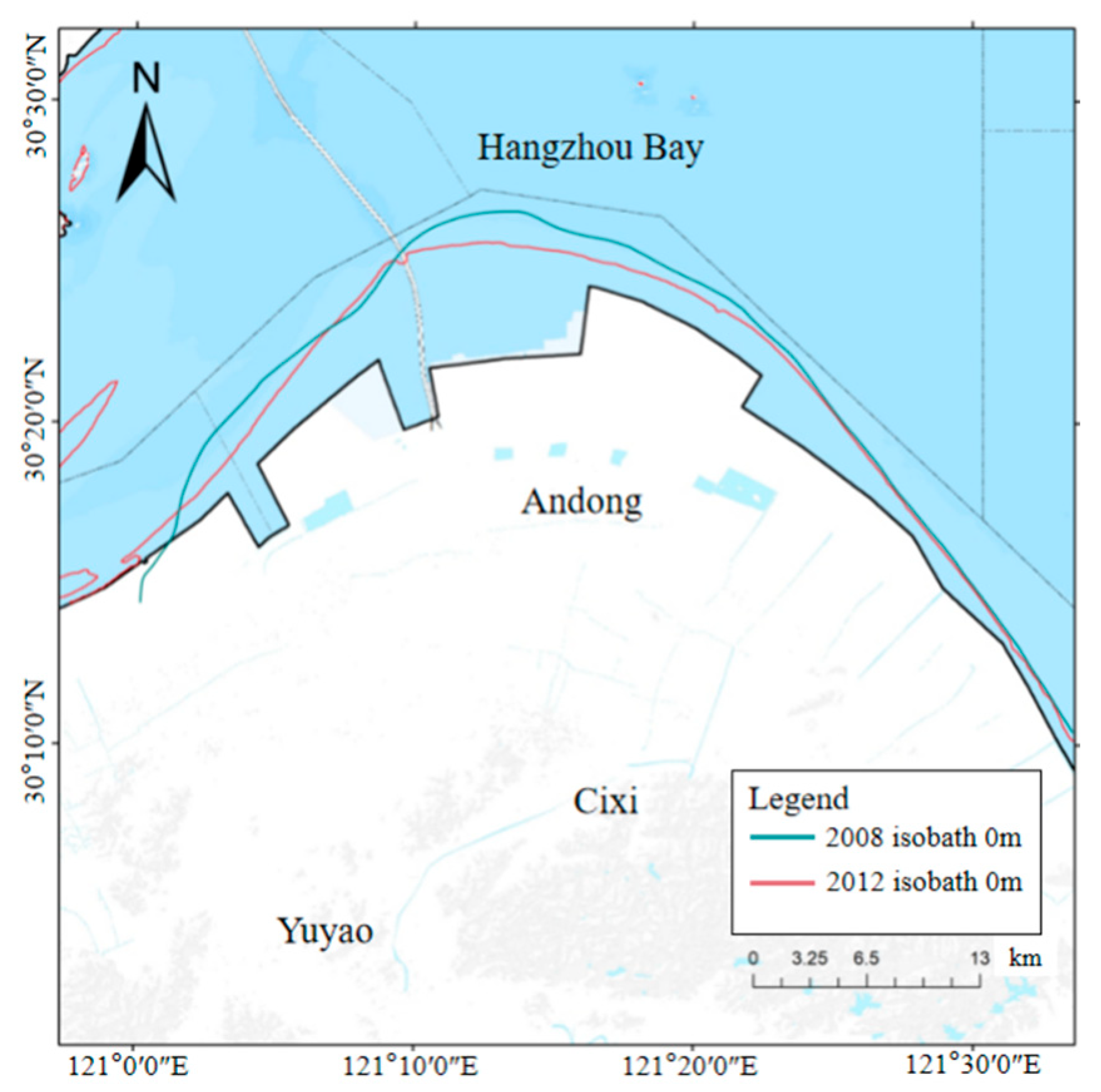1. Introduction
In response to the maritime power strengthen initiatives proposed by the 20th National Congress of the Communist Party of China, Zhejiang Province, has formulated and released the “Zhejiang Greater Bay Area Development Action Plan” to advance marine ecological civilization [
1,
2], create a beautiful ocean, and promote harmony between humans and the sea. This plan focuses on constructing an a comprehensive layout for the bay area characterized by “one ring, one belt, and one channel” (the global development strategy proposed by China aims to promote economic cooperation, infrastructure construction and cultural exchange among countries and regions along the route, fostering interconnectedness in the global economy;
https://www.piie.com/sites/default/files/documents/belt_and_road_report_-_final_chinese.pdf (accessed on 4 January 2025)) along with an industrial structure that combines specific points with broader development clusters. Coordinated efforts encompass bay area protection and development [
3], improved infrastructure interconnectivity, strengthening of bay-related industries, and the construction of new urban areas within the bay. The goal is to establish a new growth hub for marine economic development [
4]. The bay area, consisting of interconnected bays, harbors, and nearby islands, forms a unique urban space specific to coastal cities. It serves as an essential component of the coastal zone, offering rich resources and unique geographical, ecological, cultural, and economic value [
5]. Bay area economies, characterized by their distinctive spatial organization and economic forms [
6], hold a prominent position in the global economic landscape due to their openness, efficiency, vitality, and strong innovation. The advantageous geographical conditions and rich marine spatial resources serve as the foundational elements for bay area economic development. Rational utilization of marine spatial resources is essential in ensuring the sustainable development of the bay area [
7,
8].
Zhejiang Province, known for its long coastline and numerous islands, ranks as the first in China in terms of total coastline length and number of islands. The six major bay areas along the coast, from north to south, including Hangzhou Bay, Xiangshan Port, Sanmen Bay, Taizhou Bay, Yueqing Bay, and Wenzhou Bay, are crucial for the development of the province’s marine economy development and the protection of its marine ecological environment. The 13th Five-Year Plan for Zhejiang proposes the implementation of the Blue Bay Remediation Action, emphasizing the vigorous development of bay area economies. The plan aims to coordinate the protection and development of bay areas. It also promotes integrated bay area infrastructure, industrial enhancement along the coast, and the construction of new bay area cities to foster a new growth pole for marine economic development. In May 2018, the Zhejiang Provincial Party Committee and Government officially issued the Zhejiang Great Bay Area Construction Action Plan, focusing on the core economic zone of Hangzhou Bay. Hangzhou Bay, situated in the southeast coast, is an important part of the Yangtze River estuary and the Zhejiang coastal marine economic zone. The outline of China’s National Marine Economic Development Plan states that “the Yangtze River Estuary and Hangzhou Bay area possess a strong foundation and advanced level of Marine development, making it one of the most potential areas for Marine economic development in China”. This highlights Hangzhou Bay’s significant role in national marine strategic development [
9]. Over time, the abundant marine spatial resources have provided vital strategic support for the province’s socioeconomic development. However, the growing demand for maritime use and the limitations of available resources have led to increasingly prominent conflicts between development and resource conservation. The irrational layout of marine space has adverse effects on the natural environment and ecosystems of the bay areas [
10]. Scientific utilization and effective protection of the marine spatial resources in the six major bay estuaries are urgent and critical to achieve sustainable economic development in the bay areas. A comprehensive analysis of the resource and environment carrying capacity of Hangzhou Bay is both urgent and critical for achieving sustainable economic development in the bay areas. It also provides a foundation for future high-quality development and high-level protection for the bay areas.
Improving economic efficiency in the use of marine space resources is an important step toward building a strong maritime nation. Changes in marine spatial resources directly influence the regional economic structure. Through rational development, economic transformation can be facilitated, resource utilization efficiency can be improved, and sustainable regional economic growth can be promoted. Scientific marine spatial planning and management are crucial for coordinating various marine activities, preventing resources over-exploitation and avoiding environmental degradation [
11]. The ecological changes in Hangzhou Bay create heightened demands for the sustainable utilization of marine resources, emphasizing the need to maintain marine ecological balance and promote the harmonious development of the marine economy and environmental protection. Hangzhou Bay, located at the core of China’s “T-shaped” economic belt and the world-class Yangtze River Delta urban agglomeration, serves as an essential hub for inland and maritime transportation [
12]. It acts as a vital link between the Bohai Bay Economic Zone and the Pearl River Delta Economic Zone. Moreover, it occupies a pivotal position in China’s “Belt and Road” initiative and is strategically adjacent to international shipping routes, which strengthens the position of Hangzhou Bay in global trade and promotes regional economic openness and cooperation. The Hangzhou Bay marine area, as a breeding and migratory zone for various marine economic organisms, plays a crucial role [
13,
14]. It boasts abundant intertidal wetlands and ecological landscapes. Additionally, as a key maritime gateway for industrial growth and transportation to economically dynamic cities like Ningbo and Jiaxing, Hangzhou Bay plays a vital role in supporting industrial transformation within the region. Its excellent port facilities and shipping conditions attract numerous businesses, driving local economic development. With the growing demand for marine development and utilization, the scale of sea use is expanding, and the limited nature of marine spatial resources puts forward higher requirements for spatial utilization efficiency, so it is extremely important to study the use of marine spatial resources, the attributes of marine spatial resources, and the characteristics of change in the Hangzhou Bay area. Data from the Ministry of Natural Resources (
https://www.hangyan.co/charts/3275355674229344130 (accessed on 4 January 2025)) show that new marine engineering projects in China have continued to increase between 2018 and 2021, with new marine projects reaching 861 in 2022 and expected to reach 868 in 2023 and showing a trend toward larger scale. With the development and utilization of marine resources, there is a need to balance the relationship between economic development and ecological protection. Responses to these questions are imminent.
Objectively describing changes in marine bay areas and scientifically assessing the development and utilization of marine bay areas are essential for guiding rational bay and coastal zone planning and achieving the United Nations Sustainable Development Goals (SDG 14). Studies of marine bay areas usually focus on three areas including associated coastline changes [
15], coastal land use [
16,
17], and reclamation [
18,
19]. Shoreline change monitoring has been extensively conducted using remote sensing techniques over multi-decadal timescales [
20,
21,
22]. As the dividing line between land and sea, changes in the nature of the coastline reflect the spatial and temporal differences in coastal development [
23]. Therefore, the study of changes in the coastline, especially changes in its nature, is an effective method for portraying changes in the coastal environment. Shorelines are mainly properties designated by adjacent land use types, which can be classified into natural and artificial categories or more detailed types according to the characteristics of different study areas [
24,
25], and this classification method can reflect the current development status of the coastal zone to a certain extent. Scholars have also used mathematical models to quantify the extent of development and utilization of the coastal zone, among which the ecological risk assessment method based on landscape ecology is widely used [
26].
Many existing studies tend to focus on specific resource types or individual functional areas. In contrast, this research examines the diversity and changing characteristics of overall spatial resources. It encompasses various resource types, including marine usage structures, continental coastlines, and tidal flat systems, along with their spatiotemporal evolution. The aim of this study is to provide a more comprehensive perspective. Additionally, this study integrates multiple data sources, utilizing high-resolution remote sensing images and field survey data to capture dynamic changes in marine resources at a finer scale. It aims to address gaps in existing research concerning the comprehensiveness of marine spatial resource changes, data accuracy, policy effectiveness, and social interactions, providing scientific support for the sustainable use of resources in the Hangzhou Bay area. These innovative approaches contribute to advancing both theoretical research and practical applications in resource management for the region. This study is conducted based on existing research and aims to comprehensively assess the current status and utilization of marine spatial resources in the Hangzhou Bay area. The aims of this study include the following: (1) through on-site supplementary surveys and high-resolution remote sensing monitoring, the study investigates the marine areas, continental coastlines, intertidal zones, tidal flats, and overall seabed sediment dynamics; (2) the study investigates the changing trends of marine spatial resources in the Hangzhou Bay area and explores their underlying reasons. By gaining a deeper understanding of marine spatial resources, this research provides a scientific basis for sustainable development, ecological conservation, and resource utilization. Additionally, it offers valuable experience and insights for spatial planning and management in other coastal regions, promoting improved marine resource management and sustainable development. Through the localized study of Hangzhou Bay, the research can be expanded to a global application of marine resource management, which can provide practical and feasible references for other regions and promote sustainable development and management for global marine resources.
3. Data Sources and Research Methodology
In this study, we collect data on sea area rights in Zhejiang Province from 2018 to 2023. The boundary was delineated based on the scope with Zhejiang Province’s marine functional zoning and the outer boundary of the harbor area. The overview of sea area use was statistically classified using the Classification of Sea Area Use (HY/T 123-2009). The coastline data were generated from continental coastline surveillance and monitoring in 2018 and the data of Zhejiang Province’s coastline repair and measurement in 2021; the scale of the survey was 1:5000. The 0 m line uses the latest mapping results provided by the Department of Natural Resources of Zhejiang Province. In addition, we collected the “Monitoring and Evaluation of Marine Spatial Resources in Hangzhou Bay Area” and the “Technical Report on Coastline Repair and Survey of Zhejiang Province”, and used the topographic survey data of Hangzhou Bay in 2008, 2012, and 2016. The data came from two sources: one was the electronic navigational charts published by the Maritime Administration of the People’s Republic of China in different periods, and the other was the measured data by single beam echo sounding in 2016. The measurement position and measurement line are shown in
Figure 3. Another field survey is shown in
Figure 4.
The data preprocessing steps are as follows. (1) Data Cleaning: the collected remote sensing data were filtered to remove incomplete or inaccurate measurement data. (2) Coordinate System Transformation: data from different sources were standardized into a uniform coordinate system to ensure consistency. (3) Data Integration: data from electronic navigational charts and single beam echo sounding were combined to create a more complete marine topographic model. For data analysis, marine feature extraction was conducted using GIS software (ArcGIS 10.8/QGIS 3.16) to analyze features such as terrain and depth in the marine area from generated seabed topographic maps. Next, trend analysis of marine spatial resources was implemented by comparing marine data from different time periods.
Coastline data are primarily obtained through manual field measurements, where survey teams conduct on-site surveys along the coastline to record its position. In areas that are difficult to access, drones are used to capture coastline imagery. The most recent results from coastline repair and measurement projects in Zhejiang Province are used to supplement and validate the data obtained from manual and drone surveys. The detailed steps of drone imagery preprocessing, including image correction, denoising, and stitching, were performed by using ArcGIS’s Spatial Analyst and 3D Analyst extensions for raster data analysis, seabed 3D modeling, and spatial analysis, which can utilize built-in algorithms to extract terrain features and depth information of the marine area. Additionally, the GDAL toolset in QGIS was used for data format conversion and image fusion processing while the Processing Toolbox plugin optimized the data processing workflow and enhanced spatial analysis capabilities. The coastline data in this study are scaled at 1:5000, ensuring high spatial accuracy and positional precision. By cross-validating data from various sources, the reliability of the data is enhanced, ensuring the credibility of the analysis results. The referenced “Monitoring and Evaluation of Marine Spatial Resources in Hangzhou Bay Area” and “Technical Report on Coastline Repair and Survey of Zhejiang Province” provide the background information that further supports the validity and authority of the data.
We selected Landsat images in 2001, 2006, 2011, 2016, and 2021 to discuss the spatial change characteristics of the bay area by using the relevant technologies such as RS and GIS. Taking into account the number of types of sea use and the area of each type of marine use, the diversification index of the Gibbs–Martin equation [
27] was applied to measure the diversification of marine use activities. The diversity index is a metric that was used to assess the utilization of marine areas and evaluate the distribution and proportion of various marine activities (such as fisheries, shipping, tourism, and protected areas). Its significance lies in the reflection of the balance and sustainability of marine resource use, providing a scientific basis for optimizing marine spatial planning. A higher index reflects a more balanced distribution of various activities, increased diversification in marine utilization, decreased reliance on individual resources, and enhanced efforts to support ecosystem health and sustainable development, and the formula is as follows:
where
Gm is the diversity index of marine area use;
Xi is the area of the
ith marine area use type; and
n is the number of types of marine area use in the evaluation area (secondary category). (In this study, “secondary category” refers to the secondary classification of marine area use types, which is a more detailed categorization of different marine use types). The formula comprehensively considers the number of types of marine use and the area of various types of marine use. When
Gm < 1 and the larger the value, it indicates that the diversity of marine use types is better. The diversity index
Gm, ranges from 0 to 1. When
i = 1, i.e., there is only one type of marine-use activity in the study area, the value of
Gm is 0; when the number of marine-use types increases or the scale of each type of marine-use activity is similar, the value of
Gm increases accordingly and tends to be 1.
4. Results and Analysis
4.1. Changes in the Structure of Sea Area Use and Diversity of Types
The hydrological conditions of Hangzhou Bay, particularly tidal effects and changes in flow velocity, play an important role in the structural changes in sea area utilization. Tidal fluctuations not only affect the distribution of marine ecosystems but also directly impact human activities. For example, changes in sea surface area and water depth during tidal fluctuations influence the viability of activities such as fisheries and shipping. As the tides rise and fall, the usable area of the sea changes cyclically, leading to differences in the spatial distribution of sea area utilization at different times. These variations in hydrological conditions directly affect the diversity of sea area utilization types, especially in intertidal and shallow sea zones, where areas of varying depths are suitable for different types of activities [
28].
Based on the actual measurement data, see
Table 1, an analysis of the Hangzhou Bay marine usage area that reveals the following trends (
Figure 5). At the end of 2018, the total marine usage area in Hangzhou Bay reached 22.69 km
2. The largest portion was allocated to industrial use, covering 8.63 km
2, followed by transportation use with a total area of 6.17 km
2. By the end of December 2020, the total marine usage area had expanded to 34.73 km
2. Notably, industrial use increased significantly by 110.30%, reaching 18.16 km
2. Transportation use expanded by 21.34%, reaching 7.49 km
2. However, the sea use for land reclamation works decreased by 40.34% compared to 2018. In January 2022, the total marine usage area stood at 36.40 km
2. When compared to 2020, the sea areas allocated for seabed engineering, tourism and recreational, dumping of sewage, and land reclamation works remained unchanged. Industrial use and transportation use experienced slight increases, growing by 3.05% and 7.5%, respectively. The area designated for special uses slightly decreased by 6.09%. These changes reflect the dynamic nature of Hangzhou Bay’s coastal management and its diverse utilization patterns.
The rapid growth of industrial marine areas has positively driven regional economic development but has also exerted considerable pressure on marine ecosystems. The discharge of wastewater and chemical pollutants from industrial activities into the sea has resulted in water quality deterioration, threatening aquatic life [
29]. The extensive use of coastal areas for the construction of industrial facilities such as ports, factories, and processing plants has altered the natural structure of intertidal zones and coastal wetlands, destroyed the habitats of many marine species, and reduced ecosystem diversity. The discharge of the wastewater and chemical pollutants from industrial activities has led to a water quality deterioration, negatively affecting aquatic life. Pollutants such as heavy metals, chemicals, and nutrients accumulate in the marine ecosystem, causing eutrophication and hypoxia, which further stress marine organisms and alter food webs. The expansion of industrial marine areas often conflicts with other vital marine uses, such as fisheries and tourism, and encroaches upon ecologically sensitive areas such as breeding grounds and migration corridors. As industrial use increases, the ecological functions of these areas may be weakened, and their capacity of supporting both economic and environmental goals diminishes. While industrial marine use drives economic growth and strengthens infrastructure, these benefits come at the expense of marine ecosystems. This trade-off involves balancing economic and ecological priorities, where unchecked industrial expansion may compromise the sustainability of marine environments, affecting fisheries, tourism, and the overall health of ecosystems in the long run [
30]. To achieve a balance between economic development and ecological protection, governments and managers must develop and implement scientifically based strategies. This includes establishing a comprehensive marine environmental monitoring system to regularly assess water quality and ecosystem health, with a particular emphasis on the ecological status of industrial marine areas. When planning industrial marine use, it is essential to consider ecological protection zones and sensitive areas. Industrial development should be concentrated, avoiding large-scale projects in sensitive areas, and ensuring ecological protection zones are separated from industrial regions to preserve critical ecosystems and habitats. Governments should encourage the development of green and low-carbon industries, promote circular economy practices and adopt clean production methods. Reducing resource dependence and minimizing environmental impacts during industrial production, alongside undertaking restoration efforts in damaged ecological areas, will help mitigate the negative effects of industrial activities on the environment.
Figure 6 reflects the changes in the diversity index of sea use in Hangzhou Bay from 2018 to 2023. It can be seen that the diversity index of sea area use in Hangzhou Bay is relatively stable, and the diversity index has remained steadily above 0.6 in the past five years. Changes in the diversity index show that the structure of sea use in Hangzhou Bay basically tended to stabilize from 2020 onwards. Between 2018 and 2019, the Hangzhou Bay area underwent industrial structural adjustments. During this period, the proportion of aquaculture and industrial sea use grew rapidly, occupying parts of ecological sea use or other smaller-scale sea use types, leading to a decline in diversity. Additionally, during the intertidal zone restoration process of the Cixi Shoal and the southern coast of Hangzhou Bay, some sea areas were temporarily reallocated for single-use purposes, reducing other types of sea use. This transitional phase of concentrated sea use likely contributed to the decline in the diversity index. Furthermore, the gradual implementation of the outline of the Yangtze River Delta Regional Integrated Development Plan increased the demand for sea use in the Hangzhou Bay area, resulting in more concentrated utilization. Several types of sea use that account for a relatively large proportion of the total have basically remained unchanged in recent years.
4.2. Characterization of Changes in the Continental Coastline
The changes in the mainland coastline are closely related to water flow, tides, and ocean waves. The tidal effects in Hangzhou Bay have intensified the erosion and sedimentation processes along the coastline, particularly in areas with strong tidal fluctuations. The intensity, direction, and seasonal variations in water flow impact the stability and evolution of the coastline. For example, along the northern coast of Hangzhou Bay, between Jinshan and Ganpu, the combined effects of tides and water flow have accelerated coastline erosion, causing coastline retreat. Variations in hydrological conditions, especially changes in tidal effects and water flow direction, result in significant differences in coastline changes over time, further affecting the spatial distribution and utilization patterns of the coastal zone [
28].
The total length of the continental coastline of Hangzhou Bay is 185.13 km, of which 7.55 km of the native natural coastline accounts for 4.08% of the total length of the coastline, 147.12 km of artificial coastline accounts for 79.46%, 16.32 km of ecological restoration of coastline accounts for 8.82%, and 14.14 km of estuarine coastline accounts for 7.64%. As shown in
Table 2, the continental coastline of Hangzhou Bay decreased by 13.17 km, of which the muddy coastline increased by 14.98 km, the bedrock coastline decreased by 0.79 km, the ecological restoration coastline increased by 12.20 km, the estuarine coastline decreased by 14.00 km, and the artificial coastline decreased by 25.56 km, compared to the continental coastline in 2018. The comparison between the continental coastline comparisons is shown in
Figure 7.
The coastline of Hangzhou Bay has undergone notable changes, particularly in the estuarine and Cixi Shoal areas. The southern coastline, which was historically shaped by significant sediment deposition, has shifted seaward in many locations due to natural accretion. In 2021, much of the coastline moved toward the sea, primarily as a result of sediment accumulation, especially in the Hangzhou Bay estuarine region. Artificial coastlines were reclassified as ecological restoration coastlines, a trend that reflects the region’s growing focus on ecological protection. Despite these changes, human activities such as land reclamation and infrastructure construction continue to drive significant alterations in the coastline. Port expansions, deep-water terminals, and cross-sea bridges have required the expansion of coastal land, directly affecting the shape and position of the coastline. The construction of these infrastructures exacerbates coastal erosion, resulting in the retreat of natural shorelines and the shrinkage of important coastal habitats, including wetlands and intertidal zones. These habitat losses have significantly impacted biodiversity, with a decrease in the living space for birds, fish, and benthic species. In addition to the ecological challenges, coastal erosion has increased the risk of soil and water loss, particularly during extreme weather events like typhoons. The retreat of natural coastlines has weakened the ability of these areas to buffer tides, purify water, and protect biodiversity, further destabilizing the regional ecosystem. Furthermore, the waste generated from land reclamation projects has contributed to increased water pollution, placing further stress on the coastal environment and marine life.
To address these challenges, ongoing efforts to restore coastal wetlands and vegetation, as well as strengthening the resilience of the coastline to erosion, are critical. Effective policy measures, such as limiting land reclamation and reducing harmful activities like sand mining and fishing, will be essential to mitigate the impacts of coastline retreat.
4.3. Changes in Intertidal Area
Loss of intertidal habitat and degradation of important biological habitats are important factors affecting the sustainable use of nearshore resources and are major contributors to the poor health of nearshore marine ecosystems. The intertidal zone is defined as the area covered by seawater located between the high and low mean high tide, i.e., the area between the coastline and the 0-m line (theoretical depth benchmark). The intertidal zone is divided into three categories, tide pool, beaches, and rocky beach, using the classification scheme of the Technical Procedures for Monitoring and Evaluation of Mudflats (Intertidal Zone) Resources in Zhejiang Province. Rocky beach refers to the rocky platforms in the intertidal zone formed by marine erosion and gently sloping to the sea; beach refers to the sandy and gravelly accumulations in the intertidal zone formed by wave action and gently sloping to the sea; and tide pool refers to the gently and broadly sloping silt powder–sand accumulations in the intertidal zone formed by tidal action. The changes in the intertidal zone are closely linked to hydrological conditions. The rise and fall of tides directly affect water depth, sediments resuspension, and deposition in this area. In Hangzhou Bay, the intertidal zone experiences periodic changes in water depth, with seawater coverage expanding during high tide and large mudflats exposed during low tide. This process directly influences the distribution and diversity of the intertidal ecosystem, thereby affecting land use and landscape changes in the region. Specifically, the Andong Shoal experienced sediment accumulation and shoal expansion due to hydrological conditions. The combined effects of water flow speed, tidal fluctuations, and wind waves have shaped the ecological changes in this area.
According to the survey data from 2018 to 2021, the area change in intertidal zone types within Hangzhou Bay is shown in
Table 3. Between 2018 and 2021, the total area of the intertidal zone in Hangzhou Bay decreased by 73.44 km
2, of which tidal flats decreased by 69.52 km
2, beaches decreased by 4.07 km
2, and rocky beaches increased by 0.15 km
2. Except for the small increase in rocky beaches, tide pool and beaches decreased to varying degrees, especially tide pool, which had a larger decrease.
As shown in
Figure 8, the 2021 coastline was established based on the latest survey approved by the Ministry of Natural Resources. Compared to the 2018 coastline, the changes are relatively minor and are limited to specific areas, particularly the Andong Shoal, where land reclamation has caused the coastline to advance seaward by a distance ranging from 300 to 1000 m. The primary reason for the reduction in the intertidal zone area was the change in the 0-m depth line. The area of change was mainly in the estuarine area at the top of the bay, with a reduced extent of shallow flats or sandbars in the bay. Additionally, there was little variation in the intertidal zone on the northern coast, while the southern coast exhibited change in different areas, primarily characterized by a decrease in range.
4.4. Evolution of the Beach Tank System Landscape
The evolution of the tidal flat system is closely related to its interaction with hydrological conditions. The development of the tidal flats in Hangzhou Bay is primarily influenced by tides, with tidal flow playing a key role in transporting and depositing sediments. Tides cyclically alter the water depth and flow speed of the tidal flats, causing the landscape to exhibit different characteristics at various times and seasons. During high tide, the tidal flat areas may become submerged, and the increased water flow facilitates sediment transport. Conversely, during low tide, the tidal flats are exposed, allowing sediments to accumulate. Changes in hydrological conditions drive the dynamic evolution of the tidal flat landscape, affecting the area, shape, and the distribution of ecosystems within these flats [
28]. The water depths in Hangzhou Bay for the years 2008, 2012, and 2016 are depicted in
Figure 9. Overall, the general pattern of shoals and troughs remained relatively stable from 2008 to 2016. Notable changes include further erosion along the northern coast near Jinshan and Ganpu, while the southern coast experienced sediment accumulation at the front edge and flanks of the Andong Shoal. Within the bay, certain areas of the islands exhibited significant variations in sediment deposition and erosion.
- (1)
Evolution of the deep trough on the north coast
As shown in
Figure 10, scouring is more pronounced in the area between Jinshan and Zhapu between 2012 and 2016, resulting in the widening of the deep trough in the north–south direction. When comparing the 10 m and 15 m depth lines in the Jinshan–Zhapu sea area, we observed that while the 10 m depth line in the central region of Jinshan–Zhapu expanded approximately 2 km southward, the range of the 15 m depth line remained relatively unchanged, indicating stability in the deep trough area. Additionally, the 10 m depth line near the Hangzhou Bay cross-sea bridge experienced a slight reduction, suggesting gradual recovery from erosion around the bridge.
To further quantify the topographic changes in the deep trough, we compared the 20 m and 40 m depth lines in the Zhapu sea area between 2012 and 2016, which is shown in
Figure 11. During this period, the coverage area of the 20 m depth line near Zhapu extended northeastward. Upon comparison, the 20 m depth zone in this region expanded from 11.544 km
2 in 2012 to 11.653 km
2 in 2016. However, the coverage area of the 40 m depth line experienced a slight reduction, decreasing from 3.020 km
2 in 2012 to 2.945 km
2 in 2016. This indicates that the Zhapu deep trough is expanding in terms of coverage, but its depth is gradually shallowing.
- (2)
Evolution of the South Bank Andong Shoal
The Andong Shoal is a protruding bank on the southern coast of Hangzhou Bay. Its subtidal zone consists of a shallow slope with water depths of up to 5 m, while the intertidal zone covers an area of approximately 30 km
2. The expansion of Andong Shoal’s area continued from the 1930s to the 1980s. With the development of the South Bank River Treatment and Reclamation Project, the outer slope of Andong Shoal has narrowed the width of the entire water passage. In
Figure 12 (where the depicted shoreline corresponds to the year 2012), the 0 m isobaths in the western and central parts have retreated approximately 3 km landward. The shoal surface above the theoretical lowest tide level has accumulated sediment, while the subtidal seabed below experiences erosion, resulting in steeper seabed slopes. Notably, the eastern wing has not undergone significant changes.
4.5. Changes in Overall Seabed Siltation
Due to the missing depth data for the southern coast and bay entrance of Hangzhou Bay in 2016, the changes in sedimentation and erosion within the bay were compared by using topographic data from 2012 to 2016. For the area with missing data from 2016, a comparison was made using data from 2008 to 2012. The distribution of sedimentation and erosion during these two periods is shown in
Figure 13. From
Figure 13a, we observed that between 2012 and 2016, erosion dominates the changes in the depicted area. Notably, there was significant localized erosion in the central parts of the bay and at the bay’s top, with maximum erosion depths exceeding 3 m. On the southwestern side of Zhapu and along the southern coast of the bay’s top, sedimentation depths reached more than 4 m. The northern coast near Zhapu, the Qinshan sea area, and the islands within the bay experienced both sedimentation and erosion.
Figure 13b reveals that during the period from 2008 to 2012, the primary sedimentation areas along the southern coast of Hangzhou Bay included the Andong Shoal and its eastern counterpart, Zhenhai Shoal. The maximum sedimentation depth in the Andong Shoal area exceeded 4 m, while north of Andong Shoal there lies an erosion zone with maximum depths exceeding 3 m. Jinshan to the Luchao Harbor section of the sea had scouring and siltation, in which some of the small islands in the bay, such as Tanhushan Island and Dabaishan Island, etc., around the occurrence of more obvious scouring, had scouring amplitudes of more than 3 m. The scouring of the island was very obvious.
Hydrological conditions play a crucial role in changes in seabed sedimentation, particularly tidal flow and water flow intensity. In Hangzhou Bay, tidal flows and variations in flow velocity directly impact the transport and deposition of seabed sediments. Our study indicates that the seabed in Hangzhou Bay has experienced varying degrees of sedimentation, with areas experiencing stronger tidal influence accumulating sediments at a faster rate. The effects of these hydrological conditions have accelerated sedimentation in certain seabeds, particularly in shallow waters and intertidal zones, where slower water flow leads to greater sediment accumulation [
28]. To visually represent the sedimentation and erosion changes in Hangzhou Bay in recent years, the sedimentation and erosion volumes and rates for each region during the two specified periods were calculated. Between 2012 and 2016, as shown in
Figure 11 (right), the overall trend in the main bay area was erosion. The total erosion volume amounted to 192,473.74 × 10
6 m
3, with an annual erosion rate of 48,118.44 × 10
6 m
3. The average erosion depth within the region was approximately 21.80 cm, corresponding to an annual average erosion depth of 5.45 cm. During the period from 2008 to 2012, as depicted in
Figure 11 (right) for the southern coast and bay entrance area, the overall trend was sedimentation. The total sedimentation volume reached 10,459.89 × 10
6 m
3, with an annual sedimentation rate of 2614.97 × 10
6 m
3. The average sedimentation depth within the region was approximately 3.09 cm, corresponding to an annual average sedimentation depth of 0.77 cm (
Table 4).
The flow of the Qiantang River carries a large number of suspended solids and sediments into the bay, particularly near the river mouth, where these sediments can affect the bathymetric features of the bay. Under the interaction of monsoon and tidal forces, the river sediments accelerate deposition in certain areas such as the river mouth region, while other areas (such as those farther from the river mouth) may experience erosion. The flow of the Qiantang River fluctuates significantly between seasons, particularly during the flood and dry seasons, which affects the sedimentation and erosion processes at the bay’s bottom. Since the data collected for this study did not capture the seasonal fluctuations of the Qiantang River basin, a detailed analysis of this aspect is not provided here.
4.6. Characterization of the Spatial and Temporal Evolution
The hydrological conditions of Hangzhou Bay have a profound impact on the temporal and spatial evolution of the entire sea area. Changes in factors such as tides, flow velocity, and river runoff lead to notable variations in sedimentation and erosion processes within the sea area. Throughout different seasons and tidal cycles, water depth, sediment distribution, and the ecological environment in the bay undergo changes that affect spatial patterns and landscape features. For example, during low tide, some shallow areas may be exposed, while during high tide, the seawater coverage expands, and certain areas may experience sediment resuspension [
28]. These dynamic changes shape the complex temporal and spatial evolution characteristics of Hangzhou Bay. Based on the outer boundaries of the bay area, the characteristics of bay area changes were analyzed across five stages. Over the past 20 years, there has been a noticeable spatial transformation in the bay area. From 2001 to 2021, the bay area gradually shrunk (as shown in
Figure 14). This reduction in area is related to the intensified development and utilization of coastlines and sea areas, as well as the expansion of reclaimed land. The formation of Hangzhou Bay has been a lengthy developmental process. Evolution involves complex interactions between the morphology and dynamics of the boundaries (including coastlines and seabeds) and sediment transport. The overall trend of this process is reflected in both longitudinal (east–west) and transverse (north–south) variations. For centuries, after artificial reinforcement of the northern coast, the bay experienced accumulation exceeding erosion. Accumulation is primarily concentrated along the southern coast of Hangzhou Bay, while erosion occurs on the northern coast. Due to human-made coastal reinforcement, the northern coast of Hangzhou Bay reached approximately its present position in the 12th century. The southern coast has consistently exhibited an overall trend of accumulation up to the present day.
6. Conclusions
Taking Hangzhou Bay as the study area, this paper analyzes the characteristics of marine spatial resource evolution and the reasons for changes in Hangzhou Bay through an on-site supplementary investigation and high-resolution remote sensing monitoring, discusses the marine spatial planning of Hangzhou Bay, the current situation of the resources and environment of Hangzhou Bay and the problems, and puts forward countermeasures for high-quality development of the resources and environment of Hangzhou Bay and suggestions for marine ecological restoration. Through the study, it is concluded as follows:
(1) The structure of sea area uses accounts for the largest proportion of the industrial sea, and the growth rate of the industrial sea area in 2020 is 110.30% compared with that in 2018. The diversity index of sea area use in Hangzhou Bay has been steadily maintained above 0.6 for the past five years.
(2) Compared with the continental coastline in 2018, the continental coastline of Hangzhou Bay decreased by 13.17 km. Between 2018 and 2021, the total intertidal area of Hangzhou Bay decreased by 73.44 km2. The overall pattern of the beach trough in Hangzhou Bay was relatively stable from 2008 to 2016.
(3) Between 2012 and 2016, the regional scouring and siltation changes were dominated by scouring, with a maximum scouring amplitude of more than 3 m. Between 2008 and 2012, the Andong Shoal on the south shore of Hangzhou Bay and the Zhenhai Shoal on the east side of Hangzhou Bay were the main siltation areas, with the maximum silting amplitude. The maximum siltation amplitude reached more than 4 m.
(4) In the past 20 years, the spatial change in the bay area is obvious, and the area of the bay area gradually shrank from 2001 to 2021.
Therefore, in the future development and planning of Hangzhou Bay Area, efforts should be made to optimize the marine spatial structure, maximize the use of marine spatial resources, build a scientific and reasonable shoreline pattern, achieve high-quality development of Hangzhou Bay’s resources and environment, and strengthen ecological restoration to achieve the harmonious development of people and the sea. They should also safeguard national maritime rights and interests, vigorously promote the construction of marine ecological civilization, protect the ecosystems of islands and their surrounding waters, and fully implement national strategies such as the “Belt and Road” and the Yangtze River Economic Belt.
